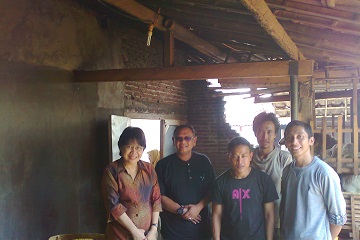Professor Chair Holder of IPB: “Tempe Cepat” Technology as Problem Solving for Tempeh Producers

Tempe is one of traditional and most delicious Indonesian food. The quality of tempe is influenced by raw materials, processing and type of inoculum used. Tempe is made up of soybean which is fermented to become tempe. Therefore management activities and stock controlling is very important for the company because its impact to the performance especially financially. However, the raw material of tempe are expensive as they have to be imported, therefore it hampers the sustainability of producers. In addition, the rapid development of urban communities have changed the urban and made tempe craftsmen to produce more.
The problem of waste disposal, especially soaking water in the acidification process is foamy and produced formidable scent that stings the nostrils, as they contain carbohydrates (cellulose, hemicellulose, and lignin) and methane. Such condition causes environmental problem. Moreover, the limited freshwater to clean soaked soybean seeds cause another problem, as freshwater in urban areas is quite expensive. Such problems that affect tempe producers must be solved. Efforts to minimize disadvantages of undesirable flavour and odour in soybean processes need a solution, to make tempeh remains affordable for its consumers.
Professor Chair Holder of the Department of Food Science and Technology of the Faculty of Agricultural Technology of Bogor Agricultural Institute (FATETA IPB), Prof. Dr. Ir. C. Hanny Wijaya, M.Agr, invented the appropriate technology innovation to accelerate the process of making tempeh to save cost. This technology is expected to be a solution to maintain tempe quality, and utilizing the traditional methods is less constant.
Prof. Hanny said, "Tempe Cepat" (Fast Tempeh) is a tempeh made by chemical acidification using Glucono Delta-Lactone (GDL) to reduce the duration of soybean acidification. The advantages of "Tempe Cepat" technology as it is environmentally friendly process. It saves water and reduces waste water immersion and speeds up the process of making tempe. In addition, the resulted tempe has a more stable quality and taste.
"The advantages that exist in this technology is expected to contribute in overcoming quality, environmental and economic problems faced by tempeh producers throughout Indonesia," Prof. Hanny said.
According to Prof. Hanny, this technology be utilized as an alternative solution for local governments as well as regulatory agencies for Micro Small Medium Enterprises (SMEs) and the environment in performing its role as a determinant of policy and public service agencies.
"Tempe Cepat" Technology developed by Prof. Hanny and her team was included as one of the innovations selected for the 100 Innovations Indonesia in 2008 by Kemenristek and Business Innovation Center.
"The technology developed currently is focused on the acidification stage. Soya acidification in tempe making contributes to the safety and acceptance of the tempeh," she said. (Wied)



